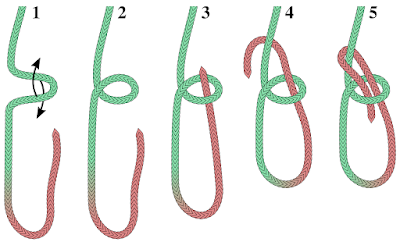Managing change is hard. But do you know what else is hard? Tying a bowline knot. I learned how to tie a bowline when I was a Boy Scout (I seem to remember that you had to be able to successfully tie a bowline before achieving the rank of First Class, but I could be wrong). It is an ancient knot that is used to form a fixed loop at the end of a rope, and it is sometimes referred to as the "King of Knots" because it is so useful. Here are the steps for tying a bowline and what it looks like at the end:
I was taught to remember the following phrase when tying a bowline: The rabbit comes out of the hole (see step 3 in the figure above), goes around the tree (see step 4), and goes back in the hole (see step 5). I suspect that this is one of the more common ways that individuals are taught how to tie the bowline, but I also learned a quick method to tie a bowline using only one hand (see the video link here). I could probably still figure out the one-handed method if I sat and thought about it, but if you asked me to tie a bowline quickly and without thinking about it, I would definitely go with the more common "rabbit method" used in the figure above. That's the way I was first taught, and it's fairly fool-proof (as long as you make the first loop - the "hole" - correctly in step 2).
As it turns out, there's a good reason that I go back to the "rabbit method". Whenever individuals are under stress, they often go back to their earliest learned behavior. There's a famous study from the 1950's that proves it ("Regression under stress to the first learned behavior"). Richard Barthol and Nani Ku randomly assigned 18 college students to one of two groups. Both groups were taught how to tie the bowline knot using the two methods above. The first group learned the "rabbit method" first, while the second group learned the quicker one-handed method first. After successfully tying a bowline several times, the students were taught the second method about four days later.
Here is where things get interesting. The students were brought to a classroom in the early morning hours (1:00 AM) after being up all night at a dance party or after finishing a final exam for one of their classes. They were all physically tired, mentally exhausted, and ready to go to bed. The students were next administered a fairly difficult standardized intelligence test. The test has 16 different sections and normally takes about 40-60 minutes to complete. However, the investigators made the students complete each section separately over the course of 3 1/2 hours. They weren't allowed to talk, leave the room, or engage in any other activities during this time. At the conclusion of the test, they were called out individually out of the room and asked to tie a bowline as quickly as possible.
Sixteen of the students (i.e. all but two) tied a bowline using the method that they first learned above. In other words, if they were taught the "rabbit method" first, they used the "rabbit method". If they were taught the one-handed method first, they used the one-handed method. Barthol and Ku concluded that "if a person has learned two alternate responses to a stimulus and is placed under stress unrelated to the behavior being observed, he or she responds to the stimulus with the earlier learned behavior pattern."
What's the take-home message here for leaders? Hopefully my prompt about change management being hard at the beginning of this post will help you figure that out. The lesson is that whenever individuals are stressed, due to fatigue, time constraints, or any combination thereof, they will invariably regress to their first learned behavior. Think about what we do to minimize the risk of a central line infection - we teach clinicians to follow a specific sequence of behaviors whenever they access the line or change the dressing on the line. Now suppose that new evidence comes out suggesting that a different method is more effective. You can certainly teach the clinical teams the new method and reinforce it as much as possible. However, as they go back to their normal daily routine, particularly if they are busy, the clinical team will revert back to the first way that they were taught to care for the central line! As John Moran and Baird Brightman write in their article "Leading Organizational Change", "The old ways of doing things have a way of creeping back into practice..."
Change is hard, because new ways of doing things only work after we establish them as habit. Unfortunately, whenever we are under stress (due to anxiety, fatigue, or time pressure, for example), we will revert back to the old way of doing things every time!

No comments:
Post a Comment